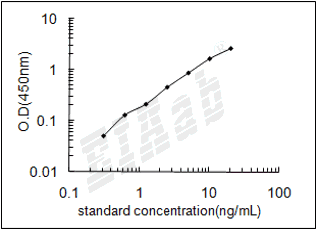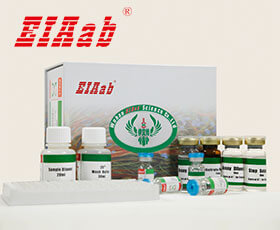GPER1 (基因名), G-protein coupled estrogen receptor 1 (蛋白名), gper1_human.
产品名称:
Human GPER1/ G-protein coupled estrogen receptor 1 Recombinant Protein
G蛋白偶联雌激素受体1
货号:
R1194h
商标:
EIAab®
监管等级:
别名:
Chemoattractant receptor-like 2, Flow-induced endothelial G-protein coupled receptor 1, G protein-coupled estrogen receptor 1, G-protein coupled receptor 30, GPCR-Br, IL8-related receptor DRY12, Lymphocyte-derived G-protein coupled receptor, Membrane estrogen receptor, FEG-1, LYGPR, mER, CEPR, CMKRL2, DRY12, GPER, GPR30
序列号:
Q99527
来源:
E.coli
种属:
Human
标签:
His
纯度:
>90% by SDS-PAGE
浓度:
Reconstitution Dependent
形态:
Liquid
内毒素水平:
Please contact protein@eiaab.com The technician for more information.
应用:
存储缓冲液:
50mM NaH2PO4, 500mM NaCl Buffer with 500mM Imidazole, 10%glycerol(PH8.0)
存储:
Store at -20°C. (Avoid repeated freezing and thawing.)
研究领域:
Metabolism
R&D 技术数据
更多信息,请参阅手册,或联系我们的技术支持: tech@eiaab.com.
基因位点
GPER1 Gene in genomic location: bands according to Ensembl, locations according to GeneLoc (and/or Entrez Gene and/or Ensembl if different)

通用注释
亚单元:
Homodimer (Probable). Heterodimer; heterodimerizes with other G-protein-coupled receptor (GPCRs) like CRHR1, HTR1A and PAQR8. Interacts (via C-terminus tail motif) with DLG4 (via N-terminus tandem pair of PDZ domains); the interaction is direct and induces the increase of GPER1 protein levels residing at the plasma membrane surface in a estradiol-independent manner (By similarity). Interacts with RAMP3. Interacts with KRT7 and KRT8. Interacts with EGFR; the interaction increases after agonist-induced stimulation in cancer-associated fibroblasts (CAF). Interacts with EGFR and ESR1.
功能:
G-protein coupled estrogen receptor that binds to 17-beta-estradiol (E2) with high affinity, leading to rapid and transient activation of numerous intracellular signaling pathways. Stimulates cAMP production, calcium mobilization and tyrosine kinase Src inducing the release of heparin-bound epidermal growth factor (HB-EGF) and subsequent transactivation of the epidermal growth factor receptor (EGFR), activating downstream signaling pathways such as PI3K/Akt and ERK/MAPK. Mediates pleiotropic functions among others in the cardiovascular, endocrine, reproductive, immune and central nervous systems. Has a role in cardioprotection by reducing cardiac hypertrophy and perivascular fibrosis in a RAMP3-dependent manner. Regulates arterial blood pressure by stimulating vasodilation and reducing vascular smooth muscle and microvascular endothelial cell proliferation. Plays a role in blood glucose homeostasis contributing to the insulin secretion response by pancreatic beta cells. Triggers mitochondrial apoptosis during pachytene spermatocyte differentiation. Stimulates uterine epithelial cell proliferation. Enhances uterine contractility in response to oxytocin. Contributes to thymic atrophy by inducing apoptosis. Attenuates TNF-mediated endothelial expression of leukocyte adhesion molecules. Promotes neuritogenesis in developing hippocampal neurons. Plays a role in acute neuroprotection against NMDA-induced excitotoxic neuronal death. Increases firing activity and intracellular calcium oscillations in luteinizing hormone-releasing hormone (LHRH) neurons. Inhibits early osteoblast proliferation at growth plate during skeletal development. Inhibits mature adipocyte differentiation and lipid accumulation. Involved in the recruitment of beta-arrestin 2 ARRB2 at the plasma membrane in epithelial cells. Functions also as a receptor for aldosterone mediating rapid regulation of vascular contractibility through the PI3K/ERK signaling pathway. Involved in cancer progression regulation. Stimulates cancer-associated fibroblast (CAF) proliferation by a rapid genomic response through the EGFR/ERK transduction pathway. Associated with EGFR, may act as a transcription factor activating growth regulatory genes (c-fos, cyclin D1). Promotes integrin alpha-5/beta-1 and fibronectin (FN) matrix assembly in breast cancer cells.
亚细胞位置:
Nucleus
Cytoplasm
Cytoplasm
Perinuclear region
Cytoplasm
Cytoskeleton
Cell membrane
Multi-pass membrane protein
Basolateral cell membrane
Multi-pass membrane protein
Cytoplasmic vesicle membrane
Multi-pass membrane protein
Early endosome
Recycling endosome
Golgi apparatus membrane
Multi-pass membrane protein
Golgi apparatus
Trans-Golgi network
Endoplasmic reticulum membrane
Multi-pass membrane protein
Cell projection
Dendrite
Cell projection
Dendritic spine membrane
Multi-pass membrane protein
Cell projection
Axon
Cell junction
Synapse
Postsynaptic cell membrane
Postsynaptic density
Mitochondrion membrane
Multi-pass membrane protein
Colocalized with BSN to the active zone of presynaptic density. Colocalized with DLG4/PSD95 and neurabin-2 PPP1R9B in neuronal synaptosomes (By similarity). Endocytosed in a agonist- and arrestin-independent manner. Colocalized with RAMP3 and clathrin-coated pits at the plasma membrane. Colocalized with transferrin receptor at the plasma membrane and perinuclear region. Accumulated and colocalized with RAB11 proteins in recycling endosomes and trans-Golgi network (TGN), but does neither recycle back to the cell surface nor traffics to late endosome or lysosome. Colocalized with calnexin in the endoplasmic reticulum. Traffics to intracellular sites via cytokeratin intermediate filaments like KRT7 and KRT8 after constitutive endocytosis in epithelial cells. Colocalized with EGFR in the nucleus of agonist-induced cancer-associated fibroblasts (CAF).
该产品尚未在任何出版物中被引用。
[1].
"G protein-coupled receptor 30 expression is up-regulated by EGF and TGF alpha in estrogen receptor alpha-positive cancer cells."
[2].
"Coordinate regulation of estrogen-mediated fibronectin matrix assembly and epidermal growth factor receptor transactivation by the G protein-coupled receptor, GPR30."
[3].
"G protein-coupled receptor 30 localizes to the endoplasmic reticulum and is not activated by estradiol."
[4].
"Identity of an estrogen membrane receptor coupled to a G protein in human breast cancer cells."
[6].
"Estrogen-induced activation of Erk-1 and Erk-2 requires the G protein-coupled receptor homolog, GPR30, and occurs via trans-activation of the epidermal growth factor receptor through release of HB-EGF."
[8].
"Identification of a gene (GPR30) with homology to the G-protein-coupled receptor superfamily associated with estrogen receptor expression in breast cancer."
[9].
"G-protein-coupled receptor 30 interacts with receptor activity-modifying protein 3 and confers sex-dependent cardioprotection."
[10].
"Minireview: G protein-coupled estrogen receptor-1, GPER-1: its mechanism of action and role in female reproductive cancer, renal and vascular physiology."
[1].
人G蛋白偶联雌激素受体1(GPER1)重组蛋白是否是无菌的?
蛋白试剂瓶和蛋白保存液是经过高压灭菌的,但也不能保证蛋白是完全无菌的。如果要求蛋白是无菌的,可以用0.2微米的滤器对蛋白进行过滤。
[2].
人G蛋白偶联雌激素受体1(GPER1)重组蛋白的保存缓冲液是什么?
纯化后的蛋白保存在PBS(58mM Na2HPO4, 17mM NaH2PO4, 68mM NaCl, pH7.4)里,并往里面加入500mM咪唑和10%甘油。
[3].
怎样确定人G蛋白偶联雌激素受体1(GPER1)重组蛋白的浓度?
蛋白浓度的确定没有一个统一的标准,这主要取决于蛋白的氨基酸序列。伊艾博是根据不同测试的组合来测定蛋白浓度。考马斯亮蓝法、BCA法、氨基酸序列和氨基酸全序列分析法等都用来测定蛋白浓度。
[4].
人G蛋白偶联雌激素受体1(GPER1)重组蛋白蛋白保存条件是怎样的?
蛋白应保存在 -20℃或 -80℃条件下,为了避免反复冻融,可以将蛋白分装成小份保存。
[5].
人G蛋白偶联雌激素受体1(GPER1)重组蛋白是否可以用于活体实验?
重组蛋白没有用于任何的活体实验,因此蛋白的活性和半衰期是不确定的。
[6].
人G蛋白偶联雌激素受体1(GPER1)重组蛋白的保质期是多久?
在适当的保存条件下,从购买之日起蛋白可以稳定保存6-12个月。适当的保存条件是:蛋白保存在-20°C o或 -80℃,保证蛋白的保存浓度高于0.1mg/ml,限制蛋白反复冻融的次数。我们公司常规的质量检测保证所有产品在销售时都有可接受的生物活性。但是我们不能控制终端用户蛋白的保存条件。如果产品在有效期内出现问题,请联系我们的技术支持。
[7].
你们蛋白和抗体的报价是怎么样的?
我们将根据你需要的蛋白和抗体的大小进行报价。
[8].
人G蛋白偶联雌激素受体1(GPER1)重组蛋白是否能够提供蛋白片段?
我们现有的人的蛋白的序列可以有很多。你可以选择你感兴趣的靶向部分,我们将会按您的需求提供蛋白和抗体。
[9].
人G蛋白偶联雌激素受体1(GPER1)重组蛋白的货期或发货时间一般是多长?
具体指标的货期需要确定。最快一周,最长可能一个月。
反馈墙
评论数 : 0
所有用户
所有用户
默认排序
默认排序
最近
早期
目前还没有评论。






通知
规格
数量
单价 (¥)
小计 1 (¥)
小计 2:
¥

规格
数量
单价 (¥)








 验证序列:
验证序列:




 折扣:
折扣: